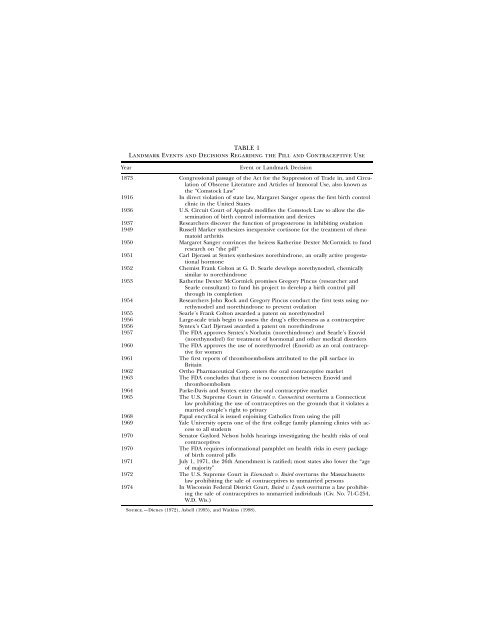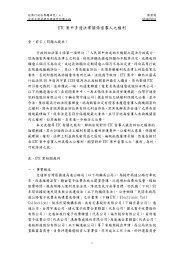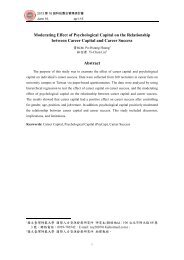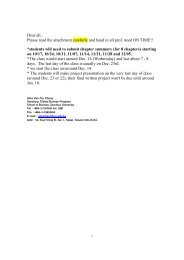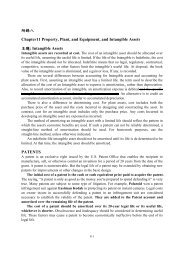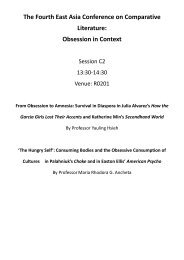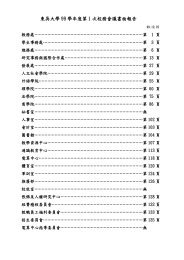The Power of the Pill: Oral Contraceptives and Women's ... - Mail
The Power of the Pill: Oral Contraceptives and Women's ... - Mail
The Power of the Pill: Oral Contraceptives and Women's ... - Mail
You also want an ePaper? Increase the reach of your titles
YUMPU automatically turns print PDFs into web optimized ePapers that Google loves.
Year<br />
TABLE 1<br />
L<strong>and</strong>mark Events <strong>and</strong> Decisions Regarding <strong>the</strong> <strong>Pill</strong> <strong>and</strong> Contraceptive Use<br />
Event or L<strong>and</strong>mark Decision<br />
1873 Congressional passage <strong>of</strong> <strong>the</strong> Act for <strong>the</strong> Suppression <strong>of</strong> Trade in, <strong>and</strong> Circulation<br />
<strong>of</strong> Obscene Literature <strong>and</strong> Articles <strong>of</strong> Immoral Use, also known as<br />
<strong>the</strong> “Comstock Law”<br />
1916 In direct violation <strong>of</strong> state law, Margaret Sanger opens <strong>the</strong> first birth control<br />
clinic in <strong>the</strong> United States<br />
1936 U.S. Circuit Court <strong>of</strong> Appeals modifies <strong>the</strong> Comstock Law to allow <strong>the</strong> dissemination<br />
<strong>of</strong> birth control information <strong>and</strong> devices<br />
1937 Researchers discover <strong>the</strong> function <strong>of</strong> progesterone in inhibiting ovulation<br />
1949 Russell Marker syn<strong>the</strong>sizes inexpensive cortisone for <strong>the</strong> treatment <strong>of</strong> rheumatoid<br />
arthritis<br />
1950 Margaret Sanger convinces <strong>the</strong> heiress Ka<strong>the</strong>rine Dexter McCormick to fund<br />
research on “<strong>the</strong> pill”<br />
1951 Carl Djerassi at Syntex syn<strong>the</strong>sizes norethindrone, an orally active progestational<br />
hormone<br />
1952 Chemist Frank Colton at G. D. Searle develops norethynodrel, chemically<br />
similar to norethindrone<br />
1953 Ka<strong>the</strong>rine Dexter McCormick promises Gregory Pincus (researcher <strong>and</strong><br />
Searle consultant) to fund his project to develop a birth control pill<br />
through its completion<br />
1954 Researchers John Rock <strong>and</strong> Gregory Pincus conduct <strong>the</strong> first tests using norethynodrel<br />
<strong>and</strong> norethindrone to prevent ovulation<br />
1955 Searle’s Frank Colton awarded a patent on norethynodrel<br />
1956 Large-scale trials begin to assess <strong>the</strong> drug’s effectiveness as a contraceptive<br />
1956 Syntex’s Carl Djerassi awarded a patent on norethindrone<br />
1957 <strong>The</strong> FDA approves Syntex’s Norlutin (norethindrone) <strong>and</strong> Searle’s Enovid<br />
(norethynodrel) for treatment <strong>of</strong> hormonal <strong>and</strong> o<strong>the</strong>r medical disorders<br />
1960 <strong>The</strong> FDA approves <strong>the</strong> use <strong>of</strong> norethynodrel (Enovid) as an oral contraceptive<br />
for women<br />
1961 <strong>The</strong> first reports <strong>of</strong> thromboembolism attributed to <strong>the</strong> pill surface in<br />
Britain<br />
1962 Ortho Pharmaceutical Corp. enters <strong>the</strong> oral contraceptive market<br />
1963 <strong>The</strong> FDA concludes that <strong>the</strong>re is no connection between Enovid <strong>and</strong><br />
thromboembolism<br />
1964 Parke-Davis <strong>and</strong> Syntex enter <strong>the</strong> oral contraceptive market<br />
1965 <strong>The</strong> U.S. Supreme Court in Griswold v. Connecticut overturns a Connecticut<br />
law prohibiting <strong>the</strong> use <strong>of</strong> contraceptives on <strong>the</strong> grounds that it violates a<br />
married couple’s right to privacy<br />
1968 Papal encyclical is issued enjoining Catholics from using <strong>the</strong> pill<br />
1969 Yale University opens one <strong>of</strong> <strong>the</strong> first college family planning clinics with access<br />
to all students<br />
1970 Senator Gaylord Nelson holds hearings investigating <strong>the</strong> health risks <strong>of</strong> oral<br />
contraceptives<br />
1970 <strong>The</strong> FDA requires informational pamphlet on health risks in every package<br />
<strong>of</strong> birth control pills<br />
1971 July 1, 1971, <strong>the</strong> 26th Amendment is ratified; most states also lower <strong>the</strong> “age<br />
<strong>of</strong> majority”<br />
1972 <strong>The</strong> U.S. Supreme Court in Eisenstadt v. Baird overturns <strong>the</strong> Massachusetts<br />
law prohibiting <strong>the</strong> sale <strong>of</strong> contraceptives to unmarried persons<br />
1974 In Wisconsin Federal District Court, Baird v. Lynch overturns a law prohibiting<br />
<strong>the</strong> sale <strong>of</strong> contraceptives to unmarried individuals (Civ. No. 71-C-254,<br />
W.D. Wis.)<br />
Source.—Dienes (1972), Asbell (1995), <strong>and</strong> Watkins (1998).


